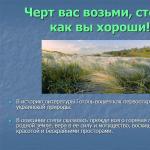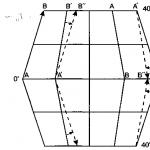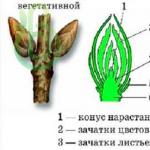The escape - This is the above-ground vegetative part of the plant. It consists of an axial part - a stem on which leaves and buds are located. On some shoots, generative organs - flowers - can also be placed. It has a more complex structure than the root.
On the stem of the shoot, nodes and internodes can be distinguished. Knot - this is the place of attachment of one or more leaves to the stem. Internodes is the distance between two adjacent nodes. Between the stem and the leaf there is an upper corner called leaf sinus . The buds are located at the top of the shoot and in the leaf axils.
Shoots, depending on the degree of elongation of the internodes, can be shortened or elongated. Shortened shoots actually consist of one node. On shortened shoots of herbaceous plants (dandelion, carrots, beets, etc.), the leaves are located close to each other and form a basal rosette.
Herbaceous plants are divided into annuals, biennials and perennials. Annuals develop and grow over one year (one growing season). In the first year of life, biennial plants (carrots, radishes, beets, etc.) form vegetative organs, accumulate nutrients, and in the second year they bloom, produce fruits and seeds. perennial plants live three or more years. Woody plants are perennials.
kidneys
kidneys - these are embryonic shoots with very short internodes. They arose later than the stem and leaves. Thanks to the kidneys, branching of the shoots occurs.
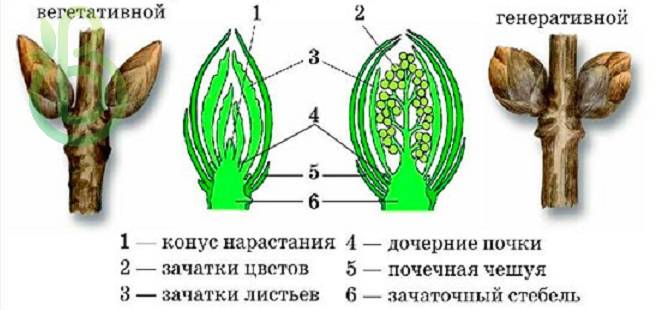
According to the location of the kidney, there are apical - located at the top of the shoot, and lateral or axillary -located in leaf axils. The apical bud provides the growth of the shoot, lateral shoots are formed from the lateral buds, which provide branching.
Buds are vegetative (leaf), generative (flower) and mixed. From vegetatively th buds develop shoot with leaves. From generative - shoot with a flower or inflorescence. The flower buds are always larger than the leaf buds and have a rounded shape. From mixed buds develop shoots with leaves and flowers or inflorescences. Buds that are laid on any other part of the stem, as well as on roots or leaves, are called adnexal , or adventitious . They develop from internal tissues, provide vegetative restoration and vegetative propagation.
By the presence of scales, the kidneys are closed (if there are scales) and open (naked if there are no scales). Closed buds are characteristic mainly for plants of the cold and temperate zones. The scales of the kidneys are dense, leathery, may be covered with cuticles or resinous substances.
Most buds develop in plants every year. Buds that may not re-grow shoots for several years (even a lifetime), but remain alive, are called sleeping . Such buds resume the growth of shoots when the apical bud, trunk or branch is damaged. Typical for trees, bushes and a number of perennial herbs. By origin, they can be axillary or adnexal.
The internal structure of the kidney
Outside, the kidney may be covered with brown, gray or brown keratinized scales - modified leaves. The axial part of the vegetative bud is the germinal stem. It has germ leaves and buds. All parts together make germ shoot . The apex of the embryonic shoot is growth cone . The cells of the growth cone divide and ensure the growth of the shoot in length. Due to uneven growth, the outer leaf rudiments are directed upwards and towards the center of the bud, bent over the inner leaf primordia and the growth cone, and cover them.
Inside the flower (generative) buds on the germinal shoot is the germinal flower, or inflorescence.
When a shoot grows from a kidney, its scales fall off, and scars remain in their place. They determine the length of the annual increments of the shoot.
Stem
Stem is the axial vegetative organ of plants. The main functions of the stem: provides the interconnection of plant organs among themselves, transports various substances, forms and bears leaves and flowers. Additional stem features: photosynthesis, accumulation of substances, vegetative reproduction, storage of water. They vary greatly in size (for example, eucalyptus trees up to 140-155 m high).
The flow of substances in the stem occurs in two directions: from the leaves to the root (descending current) - organic substances and from the root to the leaves (ascending current) - water and mainly mineral substances. Nutrients move along the core rays from the core to the cortex in a horizontal direction.
The shoot can branch, that is, form side shoots from vegetative buds on the main stem. The main stem of a branched plant is called the axis first order . The lateral stems that developed from its axillary buds are called axes. second order . Axes form on them. third order etc. Up to 10 such axes can develop on a tree.
When branching, trees form a crown. Crown - this is a collection of all above-ground shoots of trees located above the beginning of the branching of the trunk. The youngest branches in the crown are the branches of the last order. The crowns have different shapes: pyramidal (poplar), rounded (spherical) (acutifolia maple), columnar (cypress), flat (some pines), etc. A person forms the crown of cultivated plants. In nature, the formation of the crown depends on the place where the tree grows.
The branching of the stem of the bushes begins at the very surface of the soil, so many side shoots are formed (rose hips, currants, gooseberries, etc.). In semi-shrubs (wormwood), the stems become stiff only in the lower perennial part, from which annual herbaceous shoots grow every year.
In some herbaceous plants (wheat, barley, etc.), shoots grow from underground shoots or from the lowest stem buds - this branching is called tillering .
The stem that carries a flower or one inflorescence is called an arrow (in primrose, onion).
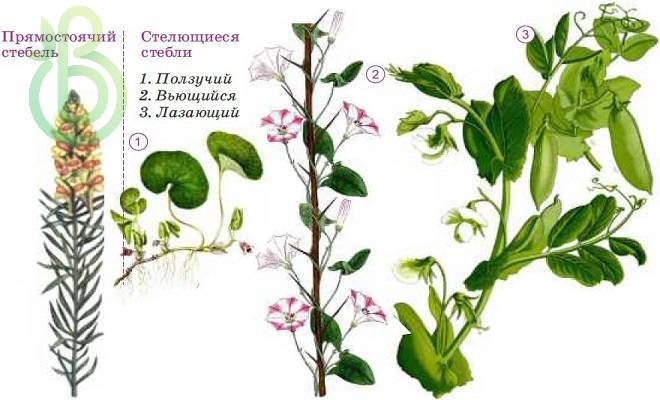
According to the location of the stem in space, they distinguish: erect (poplar, maple, thistle, etc.), creeping (clover), curly (birch, hops, beans) and clinging (step white). Plants with climbing shoots are combined into a group creeper . Creeping stems with long internodes are called mustache , and with shortened ones - whips . Both mustaches and whips are above ground stolons . A shoot that spreads along the ground but does not take root is called creeping (knotweed).
According to the state of the stem, they distinguish herbaceous stems (thistle, sunflower) and woody (beech, oak, lilac).
According to the shape of the stem on a transverse section, they are distinguished: rounded (birch, poplar, etc.), ribbed (valerian), trihedral (sedge), tetrahedral (mint, lip flowers), polyhedral (umbrella, most cacti), flattened, or flat ( prickly pear), etc.
By pubescence, they are smooth and pubescent.
The internal structure of the stem
On the example of a woody stem of dicotyledonous plants. There are: periderm, bark, cambium, wood and pith.
The epidermis functions for a short time and exfoliates. It replaces periderm , consisting of cork, cork cambium (phellogen) and phelloderm. Outside, the stem is covered with integumentary tissue - cork which is made up of dead cells. Performs a protective function - protects the plant from damage, from excessive evaporation of water. Cork is formed from a layer of cells - phellogen, which lies under it. Phelloderm is the inner layer. Exchange with the external environment occurs through lenticels. They are formed by large cells of the main tissue with large intercellular spaces.
Bark
Distinguish between primary and secondary. The primary is located under the periderm and consists of the colenchyma (mechanical tissue) and the parenchyma of the primary cortex.
Secondary bark or bast
It is represented by conductive tissue - sieve tubes, mechanical tissue - bast fibers, the main one - bast parenchyma. A layer of bast fibers forms a hard bast, other tissues - soft.
Cambium
Cambium(from lat. cambio- change). Located under the bark. This is an educational tissue that looks like a thin ring in a cross section. Outside, cambial cells form bast cells, inside - wood. Wood cells, as a rule, are formed much more. Thanks to the cambium, the stem grows in thickness.
Wood
It consists of conductive tissue - vessels or tracheids, mechanical - wood fibers, the main - wood parenchyma. The length of the vessels can reach 10 cm (sometimes - several meters).
Core
Occupies a central position in the trunk. It consists of thin-walled cells of the main tissue, large in size. The outer layer is represented by living cells, the central part is predominantly dead. In the central part of the stem, a cavity can be obtained - a hollow. Nutrients are stored in living cells. From the core to the bark through the wood passes a series of core cells called core rays. They provide horizontal movement of various connections. Core cells can be filled with metabolic products, air.
Stem modifications
Stems can perform additional functions associated with their modification. Changes occur in the process of evolution.
tendrils
These are curly, long, thin stems with reduced leaves that wrap around various supports. They support the stem in a certain position. Characteristic for grapes, pumpkins, melons, cucumbers, etc.
spines
These are shortened shoots without leaves. They are located in the axils of the leaves and correspond to the lateral axils or are formed from dormant buds on stolons (gleditsia). They protect the plant from being eaten by animals. Stem spines are characteristic for wild pear, plum, blackthorn, sea buckthorn, etc.
Tree ring formation
In trees that live in climates with seasonal changes, growth rings- on the transverse section, there is an alternation of dark and light concentric rings. From them you can determine the age of the plant.
During the growing season of the plant, one annual ring is formed. Light rings are rings of wood with large thin-walled cells, vessels (tracheids) of large diameter, which are formed in spring and during active cell division of the cambium. In summer, the cells are slightly smaller and have thicker cell walls of the conductive tissue. Dark rings are obtained in autumn. Wood cells are small, thick-walled, have more mechanical tissue. Dark rings function more like a mechanical tissue, light ones - as a conductive one. In winter, cambial cells do not divide. The transition in the rings is gradual - from spring to autumn wood, sharply marked - during the transition from autumn to spring. In spring, the activity of the cambium resumes and a new annual ring is formed.
The thickness of annual rings depends on the climatic conditions in a given season. If the conditions were favorable, the light rings are wide.
Annual rings are invisible in tropical plants, as they grow almost evenly throughout the year.

